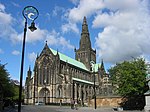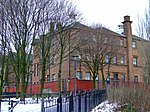Glasgow Royal Infirmary
1794 establishments in ScotlandCategory B listed buildings in GlasgowHospital buildings completed in 1914Hospitals established in 1794Hospitals in Glasgow ... and 6 more
James Miller buildingsListed hospital buildings in ScotlandNHS Scotland hospitalsTeaching hospitals in ScotlandUse British English from July 2015Voluntary hospitals

The Glasgow Royal Infirmary (GRI) is a large teaching hospital. With a capacity of around 1,000 beds, the hospital campus covers an area of around 8 hectares (20 acres), and straddles the Townhead and Dennistoun districts on the north-eastern fringe of the city centre of Glasgow, Scotland. It is managed by NHS Greater Glasgow and Clyde. It was originally opened in 1794, with the present main building dating from 1914.
Excerpt from the Wikipedia article Glasgow Royal Infirmary (License: CC BY-SA 3.0, Authors, Images).Glasgow Royal Infirmary
Castle Street, Glasgow Townhead
Geographical coordinates (GPS) Address Website External links Nearby Places Show on map
Geographical coordinates (GPS)
| Latitude | Longitude |
|---|---|
| N 55.864461111111 ° | E -4.2341777777778 ° |
Address
Glasgow Royal Infirmary
Castle Street
G4 0ET Glasgow, Townhead
Scotland, United Kingdom
Open on Google Maps









